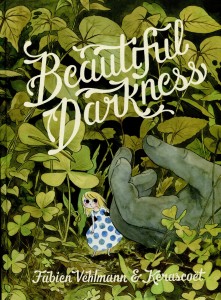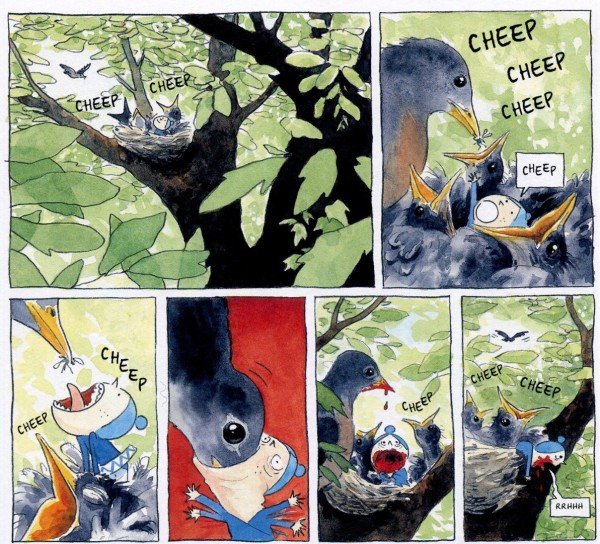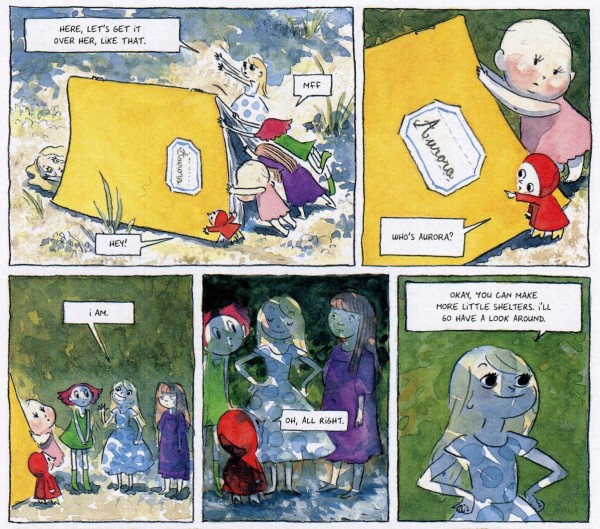What We’re Reading: Beautiful Darkness

 Beautiful Darkness by Fabien Vehlmann & Kerascoët (Drawn & Quarterly, 2014)
Beautiful Darkness by Fabien Vehlmann & Kerascoët (Drawn & Quarterly, 2014)
Beautiful Darkness (story by Fabien Vehlmann and Marie Pommepuy, art by Marie Pommepuy and Sébastien Cosset) is, as might be expected, both beautiful and dark. The story is somewhat familiar: a number of naive, childish people are lost in the woods, and as they struggle for food and shelter, hierarchies break out and grisly ends are met.
While this may sound like Lord of the Flies and its imitators, Beautiful Darkness is surprising and novel. Its ensemble cast are spritely, doll-like creatures, ranging in size from a berry to a squirrel, and they live in the woods around the corpse of a girl; some of them even live inside the body.
These grotesqueries are rendered by Pommpuy and Cosset (collectively known as Kerascoët) in lush watercolors, but while the forest environment is realistically rendered, in all its mud and maggots and fur and feathers, the tiny survivors look like they stepped out of a Saturday morning cartoon or children’s manga. I end up feeling strangely removed when, for instance, one of the cuties is eviscerated by a momma bird while imitating a chick.
These little people aren’t real, I think, and then I shiver, because that’s what these little people themselves think as they pluck the legs off beetles or steal each other’s food. The consistent pacing and clear storytelling only add to the detachment.
The truly insidious thing about Beautiful Darkness, though, is how it has infected my mind. It’s a quick read, and the ending is deliciously vengeful, but, like the action that takes place between the panels of all comics, there are a number of unanswered questions lurking behind the plot and between the scenes.
Some of these questions are straight out of the horror story toolbox: when the only vaguely heroic character (heroic inasmuch as we don’t see her doing anything too awful) rides off on her trained bird, the bird returns carrying the selfish and cruel warlord sprite and her entourage. Something happened, but the horror is left to our imaginations.
This is an obvious (and well done) case of implied action. A more subtle narrative is that of the dead girl. While she’s only shown as a corpse, doesn’t that imply that she was alive at point, perhaps at the beginning of the book? Looking back, readers see three of the sprites having hot chocolate and cake on a nice couch, disrupted by falling glop and catastrophe. The characters emerge into the woods, and behind them is the body. Were they literally living inside of her before she died? Did she contain that couch and those teacups and the stove that steamed the milk? We never see anything like that once the sprites set up in the woods; their homes and tools are all salvaged from the dead girl, her belongings, and whatever they can glean from the environment.
And the things they salvage: a fence of sharpened colored pencils, a notebook with the name “Aurora” on it (a name quickly claimed by the point-of-view sprite), scissors, and a pencil case. She was an artist.
And where did she come from, anyway? The nearest human abode, we find out, is a small cabin inhabited by a lone man who we see tinkering away and skinning rabbits. At first, I didn’t connect him with the dead girl at all. He’s never shown in mourning, nor is he acting the way a murderer might, trying to hide the body or assuage guilt. But as the only two humans in the book, one is forced to juxtapose them, and when you start looking for clues, they appear. What is he working on—is that a gun? And why does he have a broken doll in his house? And why does Aurora (the sprite; not the dead girl) love him and call him his prince in that final, haunting page?
It feels banal to try to understand the sprites and couch them in terms either symbolic or realistic. Are they Aurora’s urges, her muses, the aspects of her personality? The sprites’ perfect golden age defies realism—it seems foolish to ask how the girl’s body contained the teacups they drank from—but once you see the little people scrabbling in the dirt and slowly dying of poison, it’s impossible not to place them in the real world and ask how it happened.
But that’s the true power of Beautiful Darkness: it manages to tap into some deep, fairytale concerns but look at the real world with similarly doubting eyes. “Why do we do these things?” it asks. “How can this happen?”








Comments are closed.